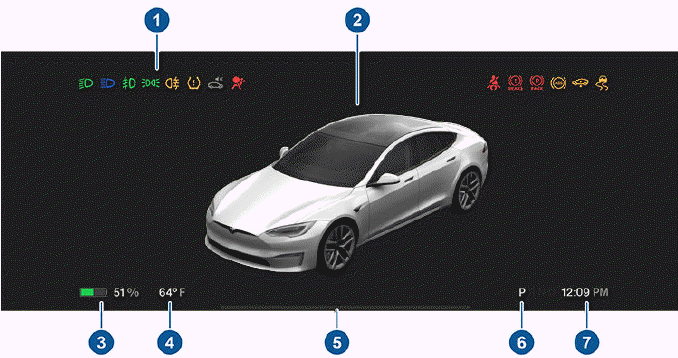Tesla Model S: Instrument Panel Overview
The instrument panel changes depending on whether Model S is:
- Off or Parked (shown below)
- Driving
- Charging
When Model S is off or Parked, the instrument panel shows remaining estimated range, vehicle status, and outside temperature.

- When the car is off and you initially press the brake, indicator lights flash briefly along the top of the instrument panel. Unless an indicator light applies to a current situation, it should turn off. If an indicator light fails to turn on or off, refer to Indicator Lights.
- An image of your car and its accompanying status (such as lights on, door open, etc.).
- Total estimated driving distance (or energy) available. Instead of driving distance, you can display the percentage of battery energy remaining. To do so, touch Controls > Display > Energy Display.
NOTE: When anticipating when you need to charge, use estimates as a general guideline only.
- Estimated outside temperature.
- Pay attention to instructions or important alert messages that display here. If any alerts are in effect, you can view information about them by touching Controls and then touching the bell icon located at the top of the screen.
- Currently selected drive mode: Park, Reverse, Neutral, or Drive. If Auto Shift out of Park is enabled, Drive or Reverse is automatically selected (based on sensor input) and displayed on the instrument panel when the driver's door is closed and seatbelt is buckled.
- Current time of day.
READ NEXT:
 Instrument Panel - Driving
Instrument Panel - Driving
When Model S is driving (or ready to drive), the instrument panel shows your
current driving status and a real-time
visualization of the road as detected by the Autopilot components (see About
Auto
 Indicator Lights
Indicator Lights
Indicator lights display along the top of the instrument
panel to show status and alert you of specific vehicle
conditions.
A brake system fault is
detected or the
brake fluid level is low. Conta
 Wipers and Washers
Wipers and Washers
You can access wiper settings by touching the wiper
button on the steering yoke or touching Controls >
Wipers.
Press the wiper button on the steering yoke to wipe the
windshield.
Press and hold
SEE MORE:
 Topping Up Windshield Washer
Fluid
Topping Up Windshield Washer
Fluid
The only reservoir into which you can add fluid is the
windshield washer fluid reservoir, which is located
behind the front trunk. When the level is low, a message
displays on the instrument panel.
To top up the washer fluid:
1. Open the hood.
2. Clean around the filler cap before opening it to
 Acceleration Modes
Acceleration Modes
Touch Controls > Pedals & Steering > Acceleration to
choose a preferred acceleration mode:
Chill limits acceleration for a slightly smoother and
gentler ride.
NOTE: When Chill is selected, Chill displays on the
instrument panel, above the driving speed.
Sport provides the normal l
© 2019-2025 Copyright www.tesms.org

